Earth is home to some bizarre creatures, there’s no question about that. But did you know that Australia has some of the weirdest? Australia broke off from other continents nearly 100 million years ago, and during that long isolation some truly strange animals showed up on the scene. In fact, nearly 70% of Australia’s mammals and more than 90% of its amphibians and reptiles are found nowhere else on Earth! In this Wildlife Spotlight post, let’s explore some of Australia’s amazing animal oddities.
Looking for more bizarre nature? Check out our top 15 weird nature facts!
For this post, I’ve hand-picked a list of the most unusual critters across Australia from my own travels on the continent and conversations with Australian nature experts. Many, but not all, of these species are found only in Australia. In other words, they are endemic. A couple others may also occur in neighboring areas like Indonesia and New Zealand.
1. Duck-billed platypus
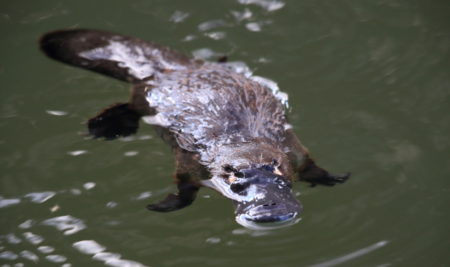
The duck-billed platypus (Ornithorhynchus anatinus) is perhaps the most well-known of Australia’s bizarre fauna. Famously, naturalists in Europe believed that the first specimens brought back from Australia were some kind of hoax! Of course, this isn’t necessarily surprising. With its webbed, duck-like feet, obviously duckish “bill” and furry, otter-like body, this animal stands apart.
The platypus is actually part of an ancient order of mammals called the monotremes (monotremata), of which there are only a few species left in the world. Monotremes lay eggs like reptiles and birds, yet have fur, give milk to their young, and have other mammalian characteristics. The platypus doesn’t stop there, however. Males also have venomous spurs on their hind legs which can give a powerful, even dangerous sting.
These weird animals of Australia are endemic to Australia. Large males can read two feet (63cm) in length and weigh up to 6.6lb (~3kg). They use their bills much the way ducks do, to root out invertebrates from the bottoms and banks of the rivers in which they live. They store energy as fat in a thick, chubby tail, and have a “sixth sense” of electrical sensitivity around their bill. This helps them locate prey without the help of their sight while hunting underwater.
2. Tasmanian giant freshwater crayfish
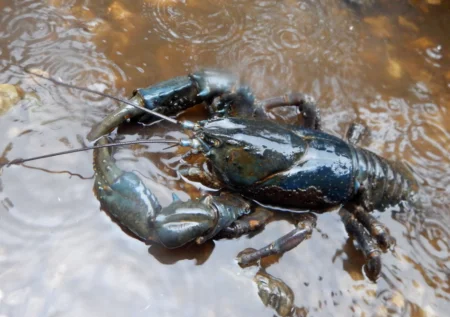
The island of Tasmania, to the South, has plenty of its own weird Australian animals. For starters, a giant freshwater crayfish (Astacopsis gouldi). Known also by a variety of indigenous names, this species holds the record for the largest freshwater invertebrate! These aren’t tiny crawdads or mudbugs creeping around in creek bottoms. In fact, due to their size, they are also commonly called freshwater lobsters! Weighing in at up to 13lb (6kg) and exceeding 30 inches (~75cm) in length, these are absolute units.
Like other crayfish, A. gouldi are omnivorous, scavenging for dead plant and animal matter and capturing small fish or insects in stream habitats. Like the large lobsters of our oceans, these crayfish can also live a long time. In fact, they may live up to 60 years! Despite their long lifespan, Tasmanian giant freshwater crayfish are endangered due to habitat loss and the heavy modification of Australia’s rivers.
Do lobsters really mate for life?
3. Rakali
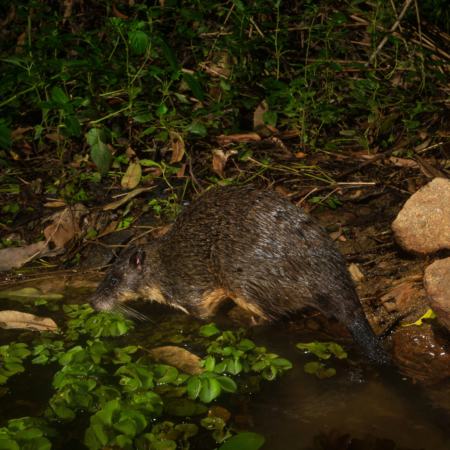
Perhaps my favorite weird animal in Australia, the rakali (Hydromys chrysogaster) is a fascinating example of convergent evolution. Its scientific name translates to “golden-bellied water mouse”, and that’s a pretty apt description! These are the largest rodents in Australia, but look more like an otter. Their flattened head and muzzle, big, rudderlike tail and webbed feet certainly don’t look very mouselike. They also have beautiful golden fur on their bellies (unfortunately a temptation for the fur trade in the past).
Why do species have scientific names?
Rakali are carnivorous like otters, and about as large as a platypus, reaching up to 2 feet (~62cm) including the tail. A far cry from your typical field mouse, these cool rodents can weigh nearly 3lbs (~1.3kg). They are highly carnivorous like their counterparts elsewhere in the world, consuming crayfish, small frogs and toads, mussels, fishes, large insects and even young waterbirds! Rakali are crepuscular, meaning that they are most active around dawn and dusk, and law low during the day and late night.
Check out this Australian radio spot about the Rakali featuring biologist Dr. Alisha Steward
One of the Rakali’s coolest claims to fame is its ability to eat the poisonous cane toad (Rhinella marina), an invasive species that has caused serious problems for most of Australia’s native mammals.
Why are invasive species bad for the environment?
4. Pygmy possum
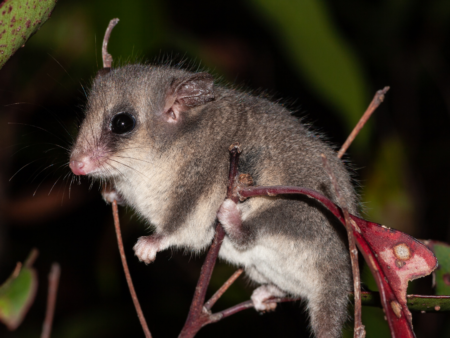
Many of the mammalian animals in Australia belong to a huge suborder called the Phalangeriformes, or possums. Unrelated to the Virginia opossum (Didelphis virginiana) which is widespread in much of North America, these animals are diverse and largely nocturnal, or night-active.
Learn about the American Opossum and how it’s different from Australian possums!
One of the most impressive members of this group, and one of the cutest animals in Australia, are the pygmy possums (family Burramydae). Four of Earth’s 5 species in this family are found only in Australia. The opposite of the Rakali, these non-rodents are tiny and mouselike, with males of the largest species getting up to in (12cm) and weighing around 1.7oz (50g). By contrast, the smallest pygmy possums max out at less than 2 inches (5cm) long and weigh only 0.35oz (10g)!
To put that into perspective: that’s a beady-eyed, big-whiskered, long-tailed critter that weighs about as much as a one or two standard pencils! These adorable animals have prehensile tails that can grab onto branches and help them climb and balance when navigating trees. As you might guess from their adorable, bulging eyes, pygmy possums are nocturnal (active at night), so they are a rare sight during the day.
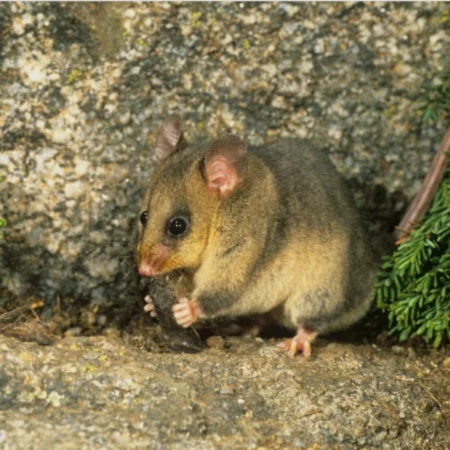
These tiny possums are important pollinators for many flowering plants including trees and shrubs, as they feed greedily on nectar and pollen. However, they are not above crunching down a delicious bug if they come across them, as well as fruit and seeds, so they have an omnivorous diet.
The mountain pygmy possum (Burramys parvus) is a particularly rare species only found in Australia’s high mountain areas. Unfortunately, due to changing in timing of their favorite food resources, this species is now endangered with steeply declining populations. Shorter winters and declining snowpack in their alpine habitats are throwing off their ability to track the emergence of their favorite food: the bogong moth (Agrotis infusa). Because of this, these bizarre, tiny possums, are disappearing fast.
Why is climate change bad for many animal species?
5. Moaning frog
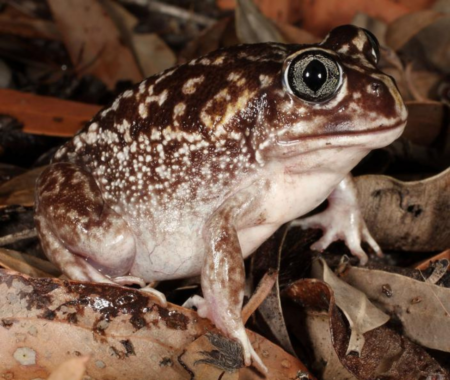
Listing off weird animals in Australia, you can’t leave out the moaning frog (Heleioporus eyrei). These odd-looking frogs live in burrows in dry Southwestern Australia, where they must battle to stay moist in a parched landscape. They build their burrows in flood prone areas, hiding from the heat during the hottest summer months. They become active during wet periods with prolonged rainfall, calling out from theirs burrows to find a mate.
The frog gets its odd name from the haunting, mournful calls that they make during their breeding period. After the first couple of summer rains, these bizarre sounds seem to be coming straight out of the ground. The frogs’ burrows may act as amplifiers, increasing the reach of their strange vocalizations.
Check out the eerie sound of this elusive amphibian here.
6. Short-beaked echidna

Just like the platypus, echidnas (family Tachyglossidae) are part of a rare and ancient mammal group called the Monotremes. Like the blue-tongued skink in reverse, echidnas and platypus are mammals that lay eggs! But the weirdness doesn’t stop there. Some echidnas also share a characteristic with marsupials during part of their lives. Specifically, pregnant female echidnas develop a pouch, in which they can store and protect their grape-sized babies after they hatch. In this way, they use both of the unusual mammal young-rearing strategies observed in Australia, marsupial pouches and egg-laying!
It’s almost like echidnas were trying to corner the market on being the weirdest animals in Australia. But they’re not done yet! All echidnas are covered in thick, sharp, modified hairs that form spines like those found on a hedgehog. Bizarrely these huge hairs are also often home to one of the largest species of fleas in the world! Echidna’s beak-like snouts house a long and powerful tongue which they use to collect ants and termites, their primary food. They also use powerful front limbs with well developed claws for digging up these and other insects, as well as for burrowing.
Australia’s short-beaked echidna (Tachyglossus aculeatus) is found throughout the continent. It is the only other echidna species outside of New Guinea, and also the only one which occurs in a temperate climate. Australian echidnas go into torpor (a bit like hibernation) during Winter when food is scarce, and hide in burrows when the weather gets too hot.
7. Emu
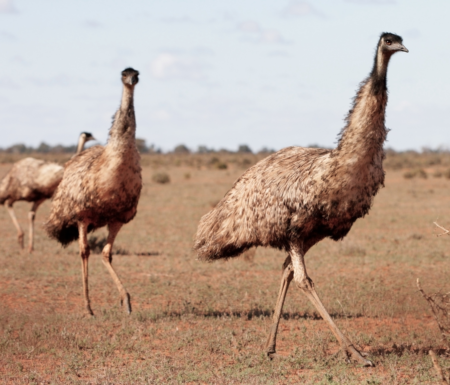
Emus are absolutely among the most famous animals in Australia, and certainly no exception to weirdness. These hulking, strange birds are distant relatives of New Zealand’s kiwis (genus Apteryx), and can reach heights over 6 feet (~2m). Being incapable of flight, they aren’t limited in bulk, and can weigh up to 120lb (55kg)!
Emus are highly social, living in somewhat nomadic family groups that roam the open areas of Western and Central Australia. They are herbivorous, eating green vegetation, seeds, fruits, and flowers where they can find them. Although they aren’t fliers, emus are migratory, making huge journeys on foot to track available water and the fresh vegetation that comes with it. Behavioral research indicates that they may cue in on visual signals like dark rainclouds on the horizon to follow available water from rainstorms.
Emus make fantastic dads. Just like the South American rheas (genus Rhea), female emus ditch hubby with their eggs after mating. Dad then incubates the eggs and protects the nest until the young have hatched. To top off the weirdness of these undeniably strange birds, emus also “won” a “war” against the Australian army in the early 20th century. You can learn more about that head-scratching historical tidbit here.
8. Blue-tongued skink

Skinks of the genus Tiliqua include some of the largest species among all of the world’s skinks. These bulky lizards are found throughout much of Australia. Not particularly fast or agile, they are ambush predators that feed on slow-moving invertebrate prey. Typical prey include terrestrial mollusks like snails and slugs, as well as larger beetles that can’t outrun a well-hidden lizard.
These skinks get their name from an especially odd characteristic: their large, vibrant-blue tongues! When threatened, Tiliqua lizards open their mouths wide and stick out their colorful, large tongues. These sudden flash of color is thought to startle and confuse would-be predators into giving them some breathing room. Fascinatingly, these lizards can actually increase the vividness and brightness of the blue color on their tongue while making this bizarre and ferocious threat display.
Here’s another weird Australian animal fact: blue-tongued skinks, like other members of their odd family, give live birth! This means that rathe than laying and incubating eggs like birds and most other reptiles, their young emerge fully formed.
9. Numbat
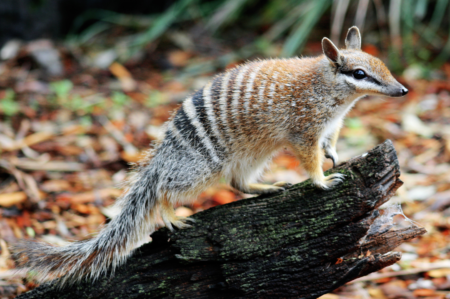
The numbat (Myrmecobius fasciatus) or banded anteater is another endangered animal in Australia. These odd-looking marsupials specialize in eating termites, and are one of very few diurnal (daytime-active) mammal species in Australia. With a curious bottlebrush tail and a sticky tongue up to inches (11cm) in length, they are odd critters by any measure.
Numbats have a sharply pointed nose for poking around in the ground for termites, and odd “peg teeth” rather than true teeth like many other mammals. Their bizarre teeth are no doubt related to their termite-heavy diet. Adult numbats typically end up eating ~20,000 termites per day to survive! Setting them apart from the already weird marsupials, numbats don’t have a complete pouch, but instead a little fold of skin where mom numbats keep their babies.
10. Bush stone-curlew
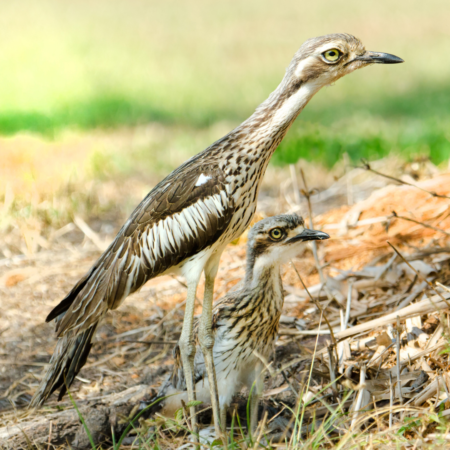
Also known as the bush thick-knee, the Bush stone-curlew (Burhinus grallarius) does an excellent job representing the birds among Australia’s weirdest animals. As its funky name implies, it looks something like a shorebird and has long, gangly legs with thick “knees”. Unlike many other birds, this species is largely nocturnal, laying low during the day and wandering open areas at night. Their huge, goofy-looking eyes and rather unimpressive coloration make sense when you considering their night-owl habits.
Like the moaning frog, bush stone-curlews also sound weird. Their spooky, plaintive, tremulous calls can be heard near the coast in much of Australia. The first time I heard their odd “weeloo” in a city park in Brisbane, I was absolutely perplexed! After some searching, I found two of these strange animals standing together under a tree and yelling every few minutes.
Another strange thing about bush-curlews is their defensive behavior. Unlike many other birds which flee when disturbed, stone-curlews freeze! This can make it easy to get great pictures of them, but you might also be standing next to one without noticing. Spotting this huge-eyed, bizarre creature so close when you least expect it can be a bit of a shock. Ask me how I know!
11. Phascogale
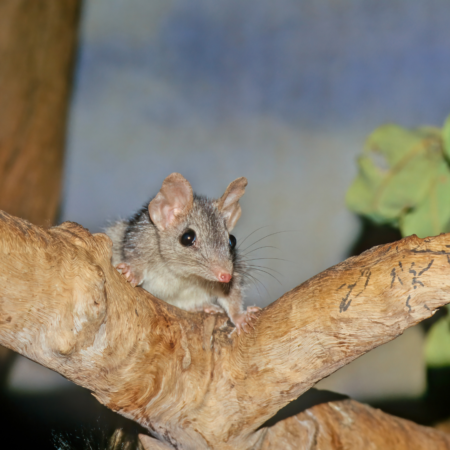
Also known as wambengers, or, better yet, “mousesacks”, phascogales (genus Phascogale) don’t look weird so much as they act weird. And with names like that, they deserve mention in this highlight reel of weird Australian animals. Phascogale means “pouched weasel”, and this tiny possum-like marsupials do look like some kind of hybrid between a mouse and a weasel. Only a few inches long, they are surprisingly athletic and can jump nearly 7 feet (>2m).
Phascogales are tiny carnivores, eating insects, spiders, and small birds and mammals if they can get a hold of them. Like other small predators, they live fast-paced lives. This is especially true for male phascogales. Why, do you ask? Here’s where it gets weird:
Male phascogales in the wild live for less than 1 year. Born in late Austral Winter, by May or June (the following Winter), they engage in what others have described as “a period of frenzied mating”. In fact, this romantic period is so intense that the males typically die of exhaustion and disease afterward! Females will go on to nest in a tree cavity where they raise their young. In contrast to the males, females may live up to 3 years in the wild. For the males, however, it’s apparently about going out with a bang.
12. Bilby
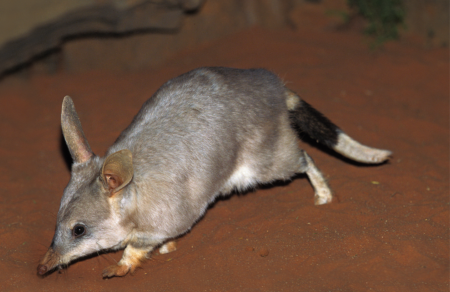
The bilby (Genus Macrotis) is one of those weird animals of Australia that is just hard to describe. This is because bilbies have an especially strange combination of mammalian characteristics. For instance, rabbit-like ears wouldn’t be too odd on their own, but combined with a trunk-like snout, long tail, and bulging eyes, its an unsettling combination.
There were once two species of bilby, both endemic to Australia, but the lesser bilby (M. leucera) sadly went extinct in the early 1900’s. The greater bilby (M. lagotis) is listed as vulnerable by the International Union for the Conservation of Nature.
Bilbies live in dry parts of mainland Australia, where they emerge at night to feed on insects, seeds, arachnids, plant roots, fungi, and other small animal prey. During the day, they hide in deep burrows with lots of twists and turns that provide security from larger predators. Just as with burrowing species like badgers and tortoises in other parts of the world, bilby burrows provide homes and shelters for lots of other wildlife.
Bilbies also have one of the shortest gestation times of any mammal. Specifically, female bilbies are pregnant for only about two weeks! Then, as with other marsupials, their tiny joeys can crawl out of the birth canal and grow safely in their mother’s pouch until they grow large enough to be more independent.
13. Marsupial mole
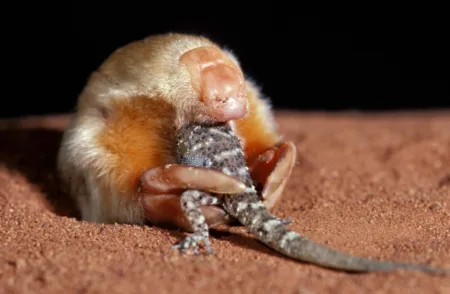
Australia is home to two species of marsupial moles in the genus Notoryctes. Although totally unrelated to the moles (family Talpidae) of the Americas and Eurasia, they are strikingly similar in structure and appearance. This is a great example of convergent evolution, just like the rakali and otters, where species that do similar stuff have similar traits or adaptations.
Just like moles elsewhere in the world, marsupial moles are fossorial (living underground). They have powerful forelimbs with strong claws for digging, although interestingly they dig using a different motion than other moles. Rather than using lateral (side to side) movements, they move their limbs up and down to dig. Since living underground makes things like eyes and open ears a liability (would you want dirt in your eyes all the time?) their eyes have been reduced to vestigial lenses covered up with skin. As such, these moles are functionally blind. They also have no ears with external openings.
The marsupial mole’s strange face, featuring a leathery “shield” of skin over the forehead and muzzle, helps protect them as they burrow through the ground. Unlike other marsupials that have forward-facing pouches to hold their babies, the marsupial mole’s faces backwards. Think about it: if they faced the other way, they would fill up with sand while they tunneled along!
14. Tawny frogmouth
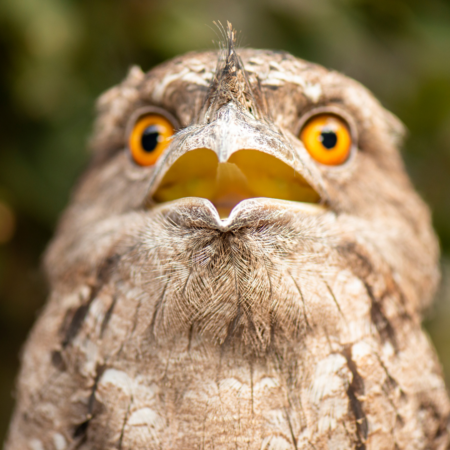
Although this bird is not unique to the land Down Under, it’s too much of an oddball not to make the list of weird animals in Australia. The tawny frogmouth (Podargus strigoides) is a species of owl-like nocturnal bird related to nightjars like the North American whippoorwill. These bizarre-looking animals are common in most forested habitats throughout Australia, where they spend they remain camouflaged during daytime. At night, they hunt a variety of insect prey, and also take small animals like frogs, lizards and songbirds. Unlike owls, they do not have talons for capturing and killing prey, but instead rely on their bills.
Check out these 11 amazing examples of animal camouflage!
With mottled gray-brown plumage that closely matches treebark, frogmouths can “shapeshift” to look like pieces of the trees that they inhabit. To better enhance this disguise, the stretch out their necks and extend their bills to assume posture like a broken branch. When they’re asleep, their spooky eyes remain closed and hidden, but their intense orange stare is a dead giveaway when they are alert.
15. Wombat

Wombats (family Vombatidae) are a group of stocky, large-bodied, burrowing marsupials unique to Australia. These animals can be as big as a medium-sized dog (over 3 feet/1m in length!) and considerably chunkier (25-77lbs / 15-35kg). However, they aren’t exactly dog-like in shape. Wombats have a chubby, powerful, heavyset body more similar to something like a badger. There are three species of wombat in the world, including the Northern and Southern hairy-nosed wombats (Lasiorhinus krefftii and L. latifrons, respectively) and the common wombat (Vombatus ursinus).
Wombats construct more elaborate and extensive burrow systems than bilbies, and females have backward-facing pouches like the marsupial mole. Wombats are most active outside their burrows at night, making them rather elusive and hard to see in the wild. Just like the famous sloths of tropical rainforests, wombats have a slow metabolism and eat only plant matter. Wombats graze on a variety of grasses, and forbs (herbaceous plants), and will also chew roots underground and the bark of trees.
Looking for an especially odd Australian nature fact? Get this: wombats take cube-shaped poops! Since they eat vegetation in very dry environments, their bodies are adapted to take as much moisture as possible out of the plant matter that they eat. Their long digestive process (some 14-18 days!) compacts their poo in the gut, leading it to emerge neatly packaged. The result? wombat poo has the look of a well-shaped charcoal briquette!
Wombats use this poo as a sort of territory marker and advertiser of their status and presence. This is similar to how dogs pee on fire hydrants or other objects to advertise themselves in an area. With their hearty, high-fiber herbivorous diet, wombats have plenty of poo to leave around. One scientific study estimated that they take 80-100 poops per night!
Thanks for reading about the weirdest animals in Australia!
If you enjoyed this post, please share it with friends and like and follow Gulo in Nature on Facebook and Instagram. Got a great idea for a future post? Share with us in the comments, or reach out using the Contact Page. We’d love to hear from you!

